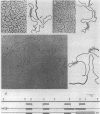Abstract
We have isolated a clustered gene family in D. melanogaster that codes for trypsin-like enzymes. The gene family has been localized to 47D-F by in situ hybridization to polytene chromosomes. The four genes in the family are transcribed in alternating orientations, and code for 1000 nt mRNAs. Transcripts are present at all stages of the life cycle. In situ hybridization to mRNA in tissue sections of third instar larvae showed that transcripts were restricted to the mid-gut. One gene was sequenced. The translated amino acid sequence of the proposed active enzyme is 42% homologous to bovine trypsin. Regions of functional importance are more strongly conserved. These include the active site residues asp102, his57, ser195, and the residue asp189 which is reputed to bind the basic residue at the substrate cleavage site. The activation peptide is not homologous to that of most vertebrate trypsins, suggesting a modified activation mechanism. The sequence further strengthens the hypothesis that the chymotrypsin cleavage specificity developed separately in the vertebrates and invertebrates.
Full text
PDF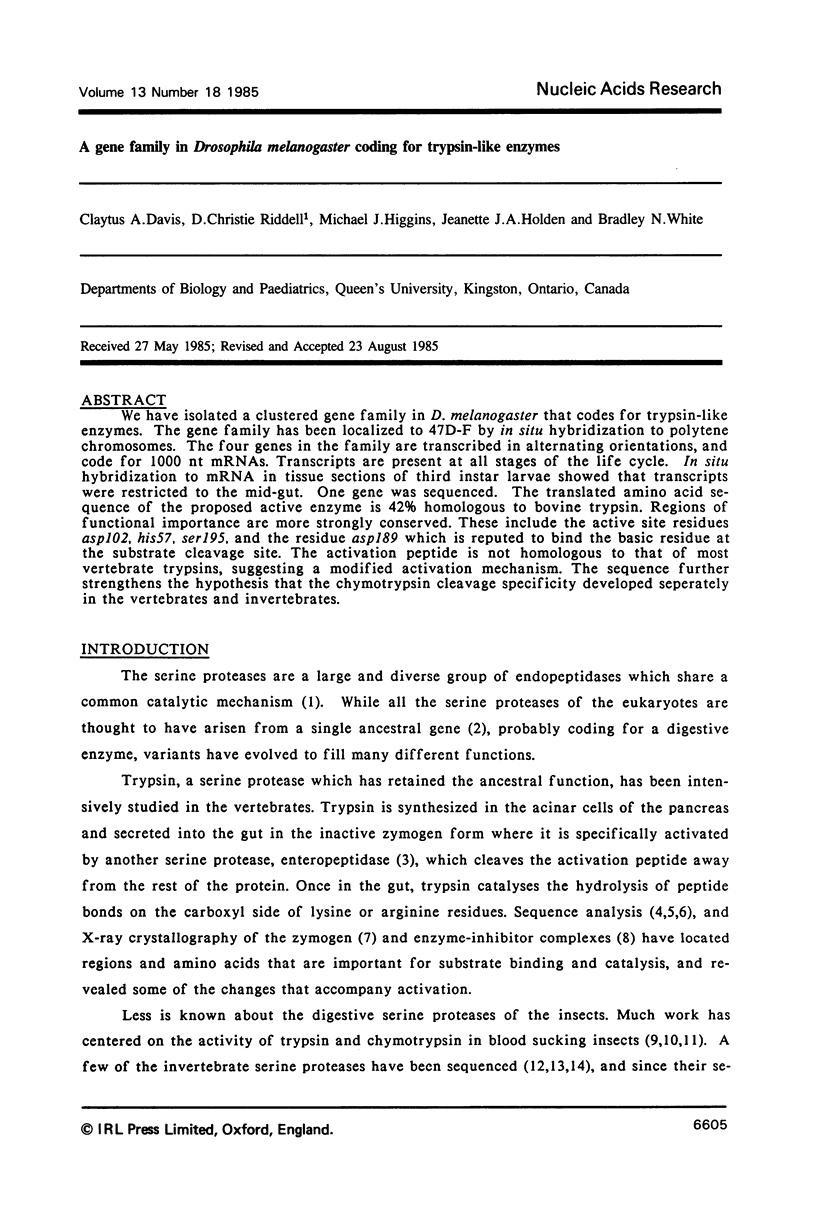
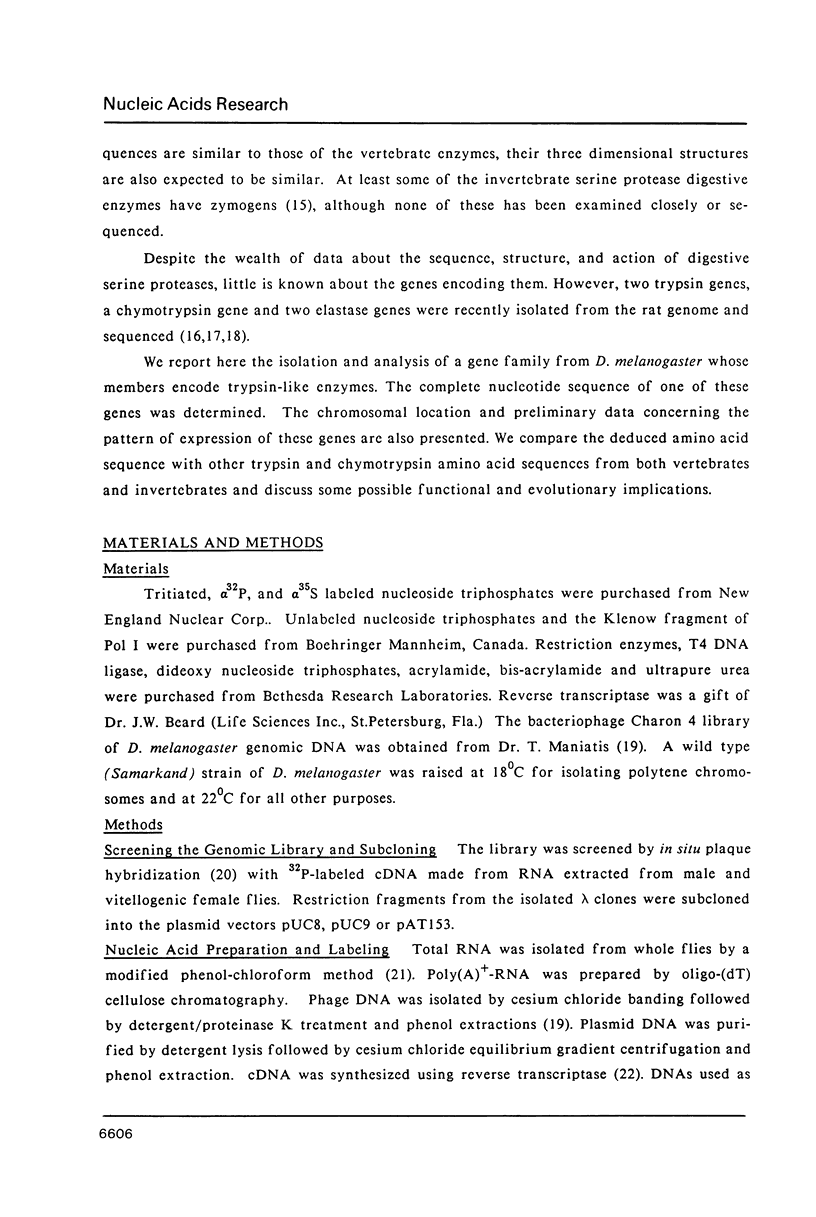
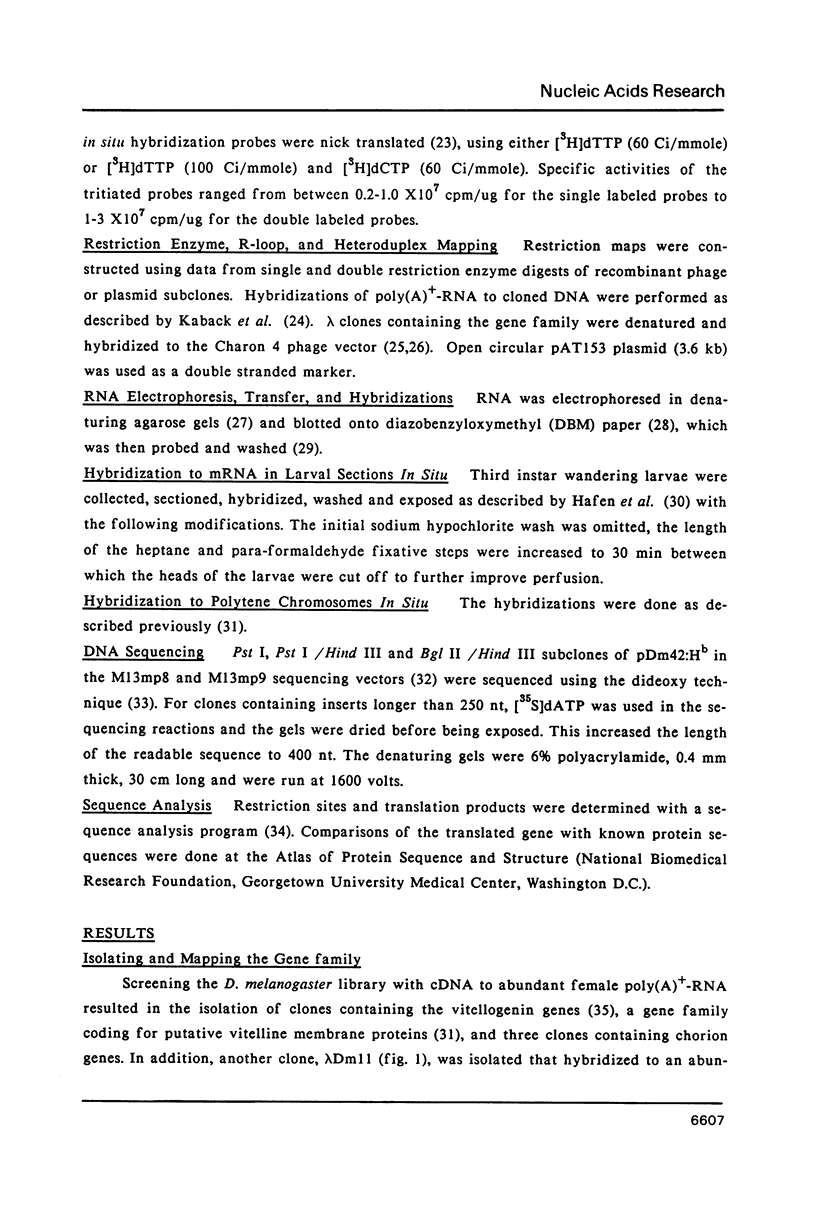
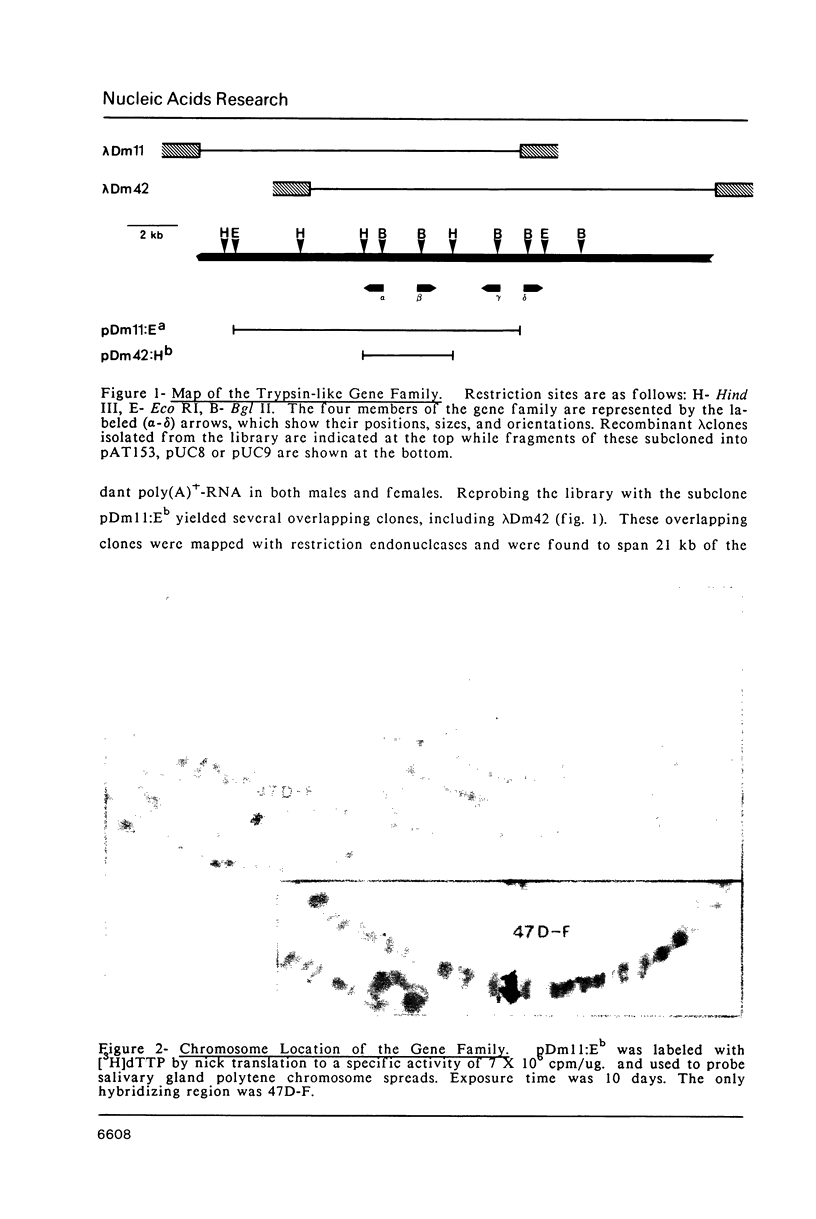

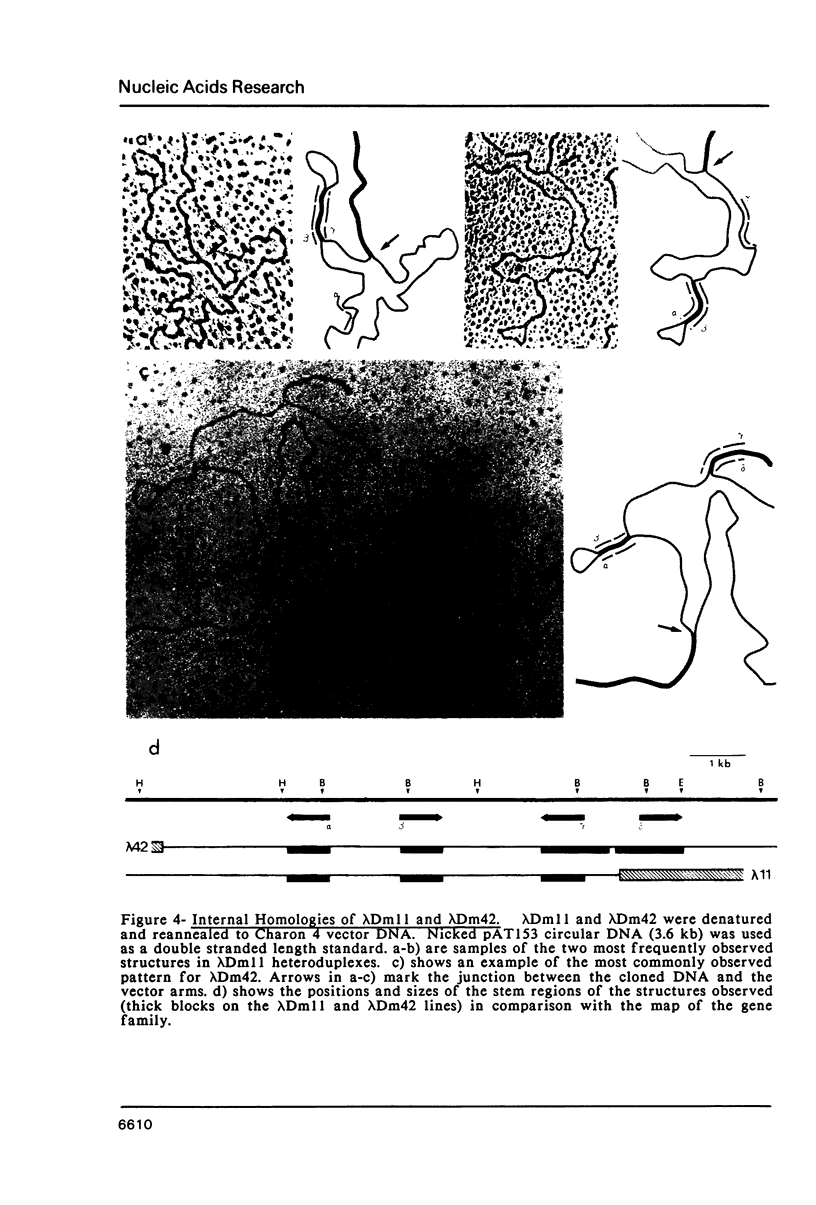
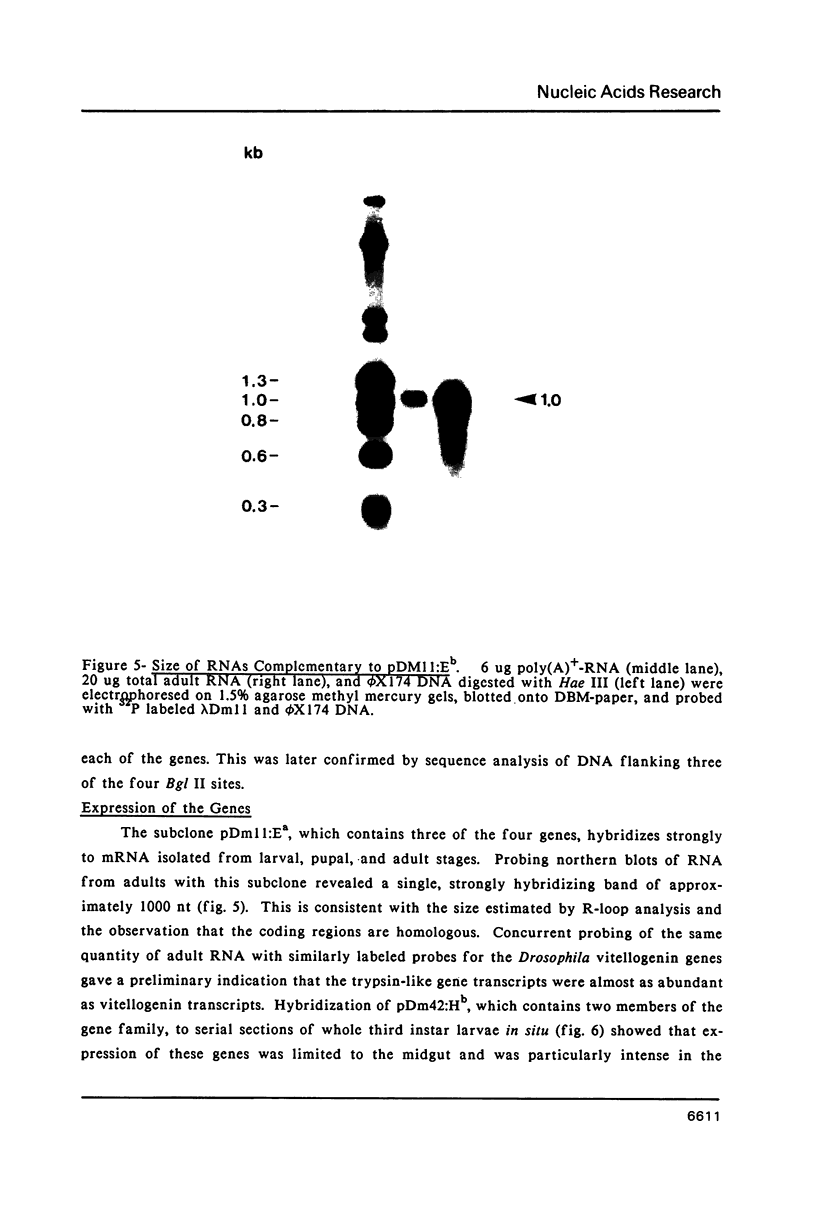
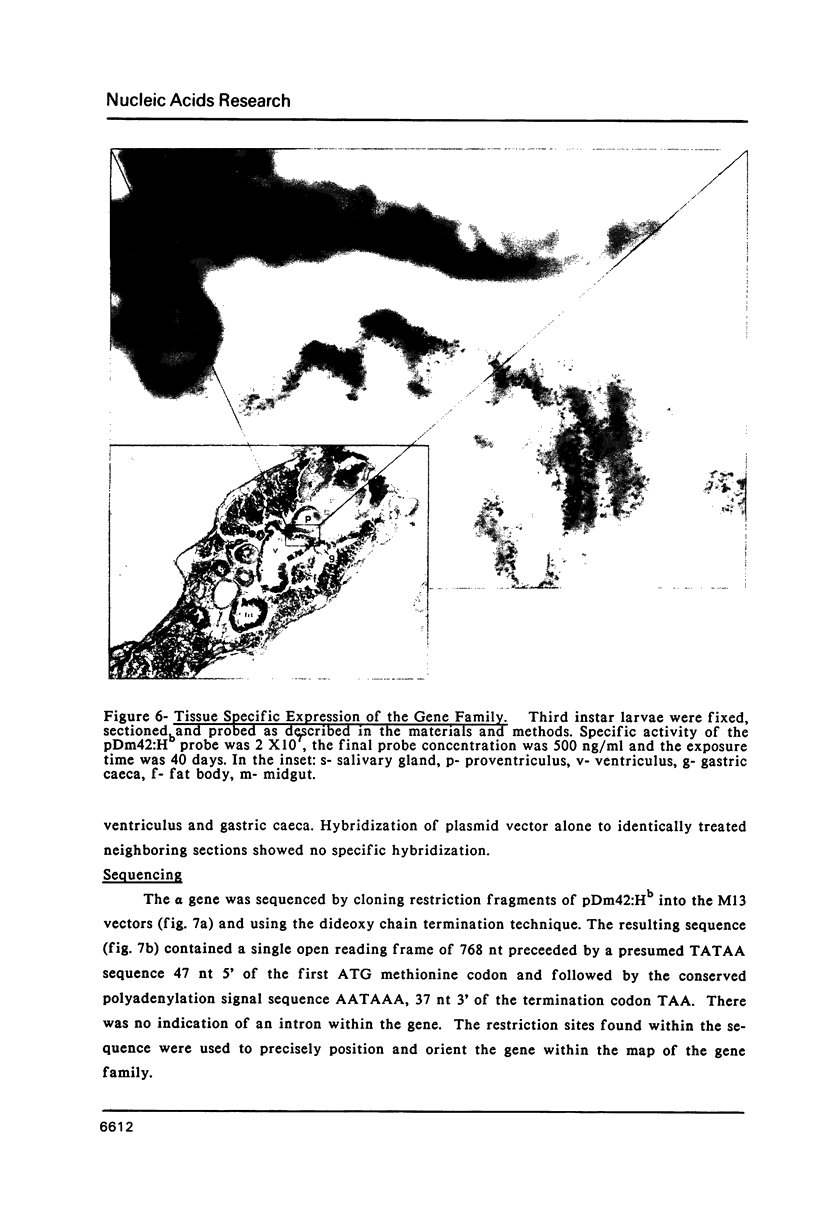
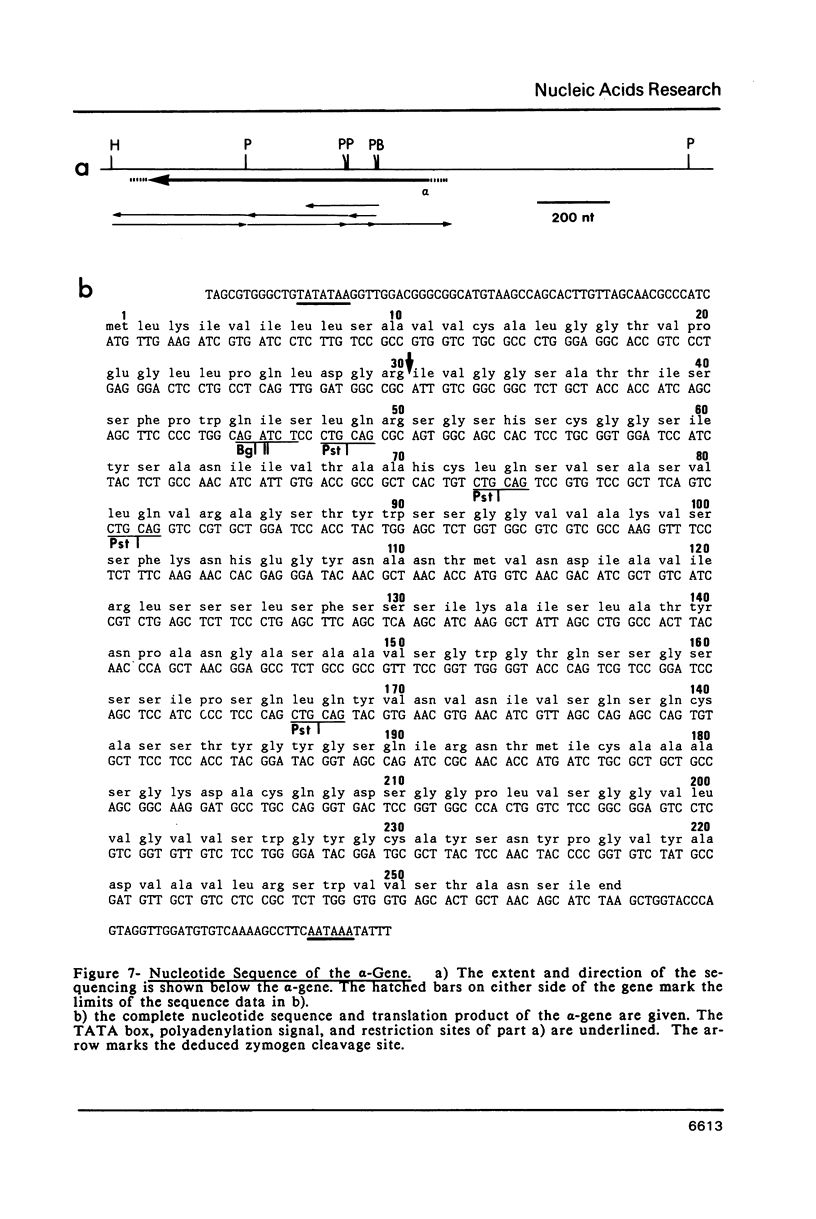
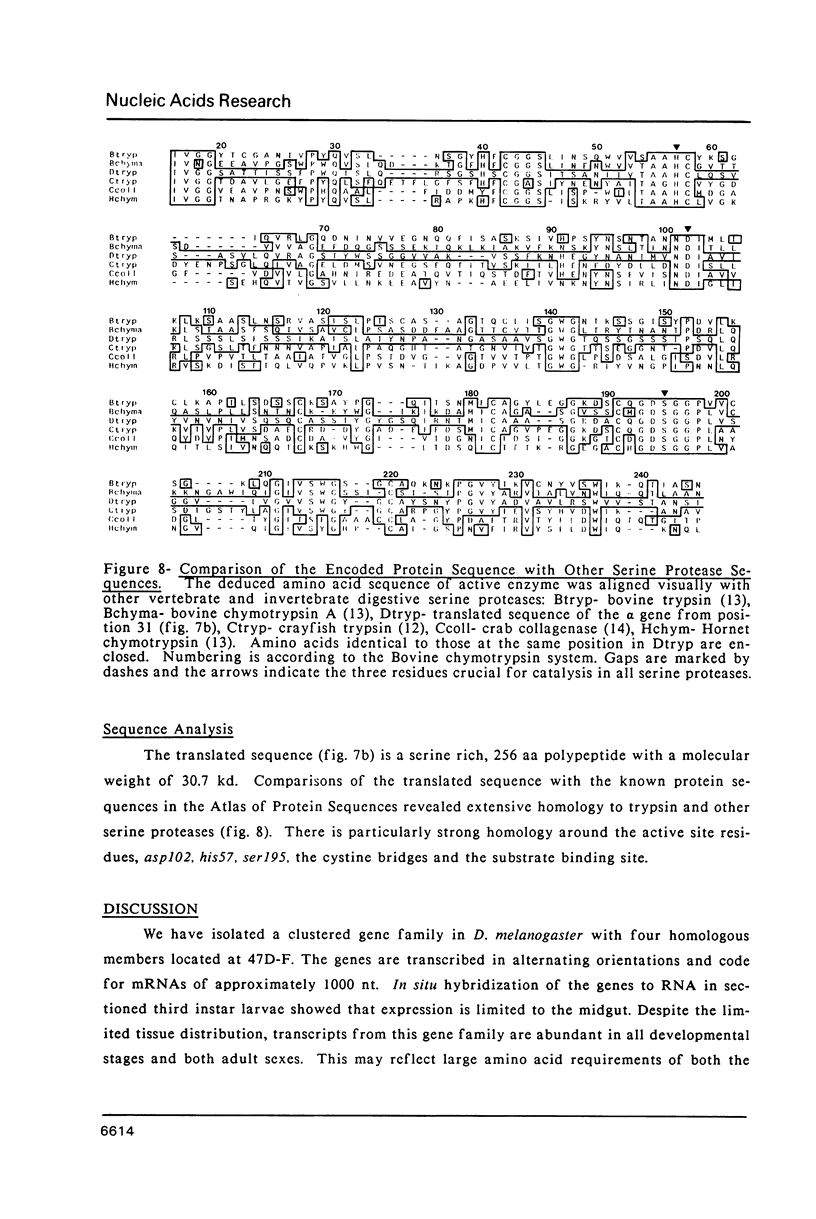
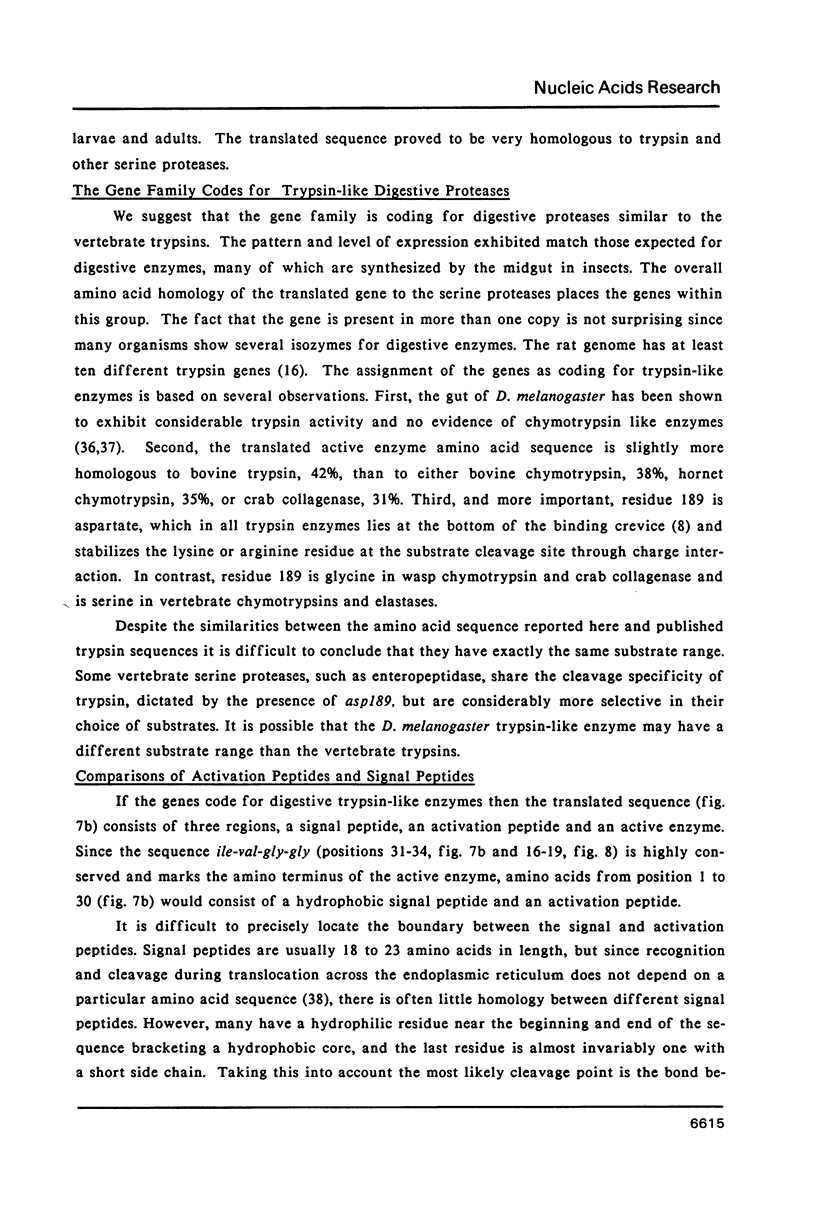
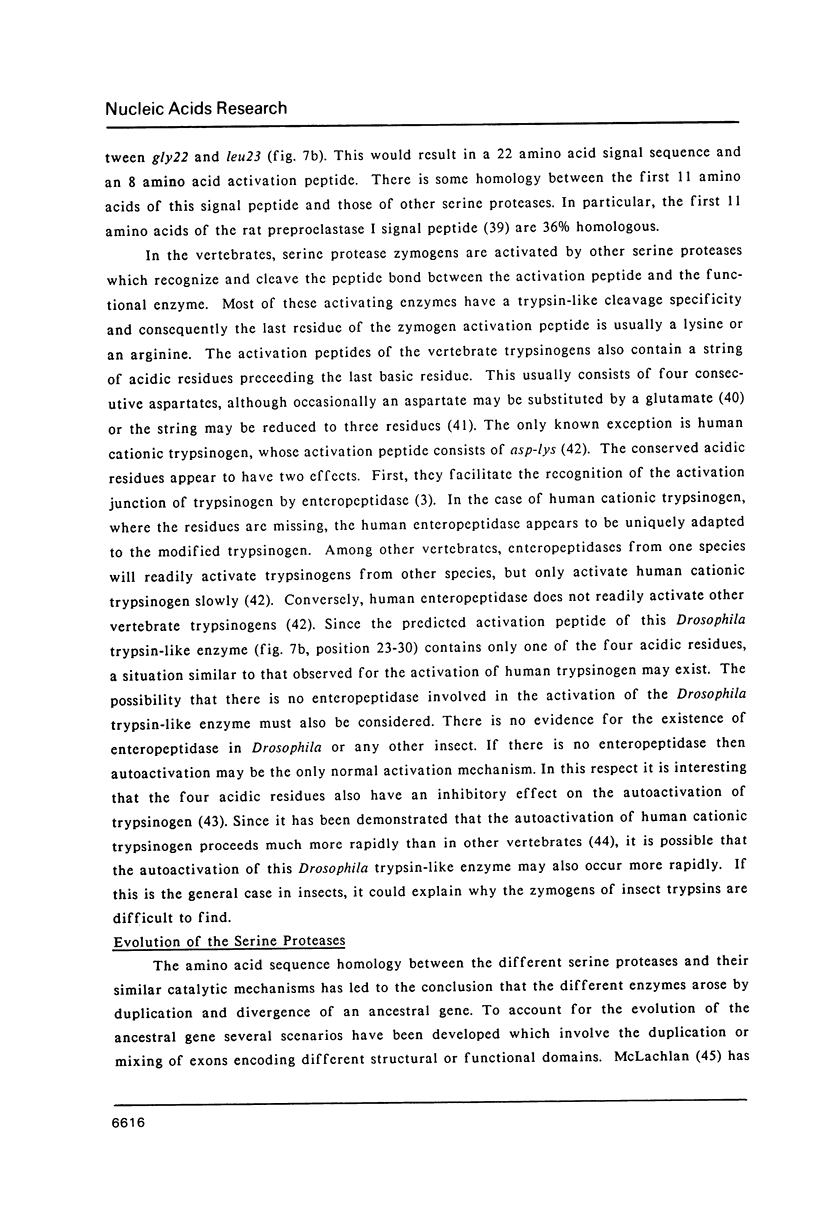
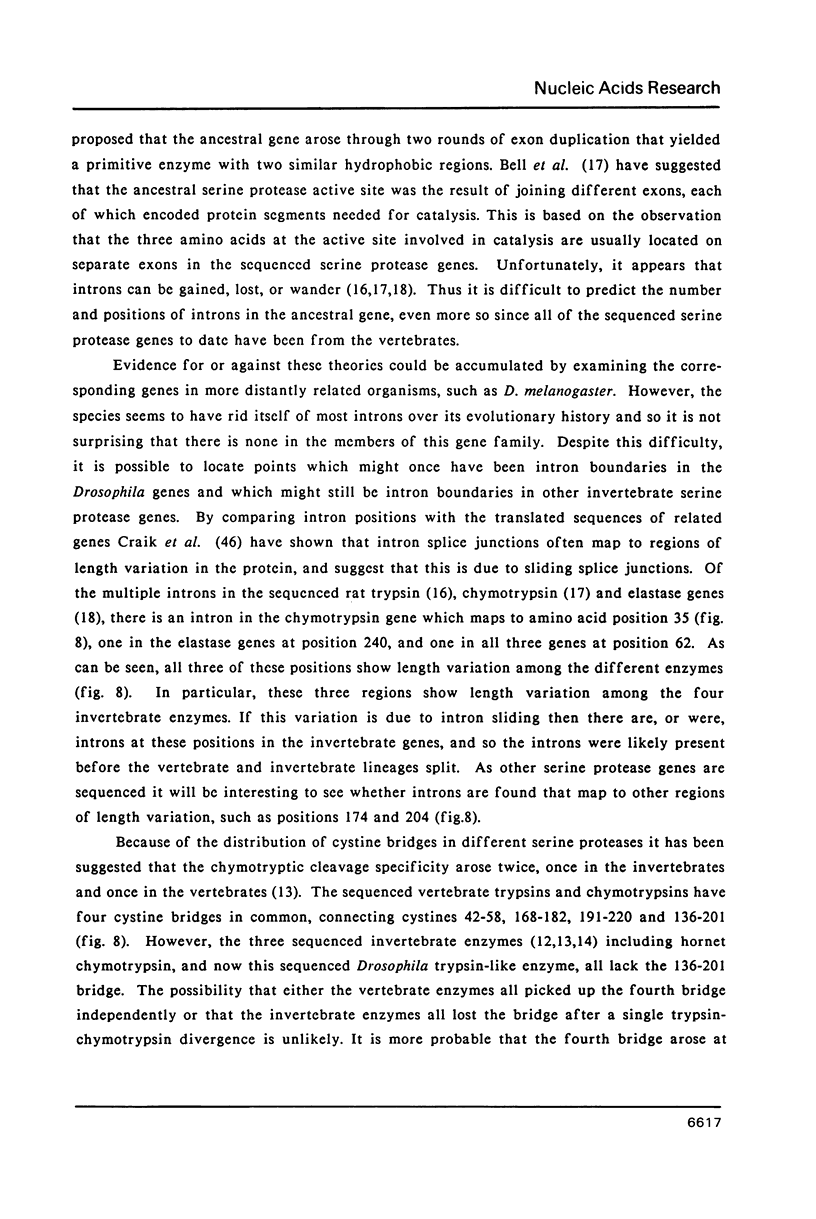
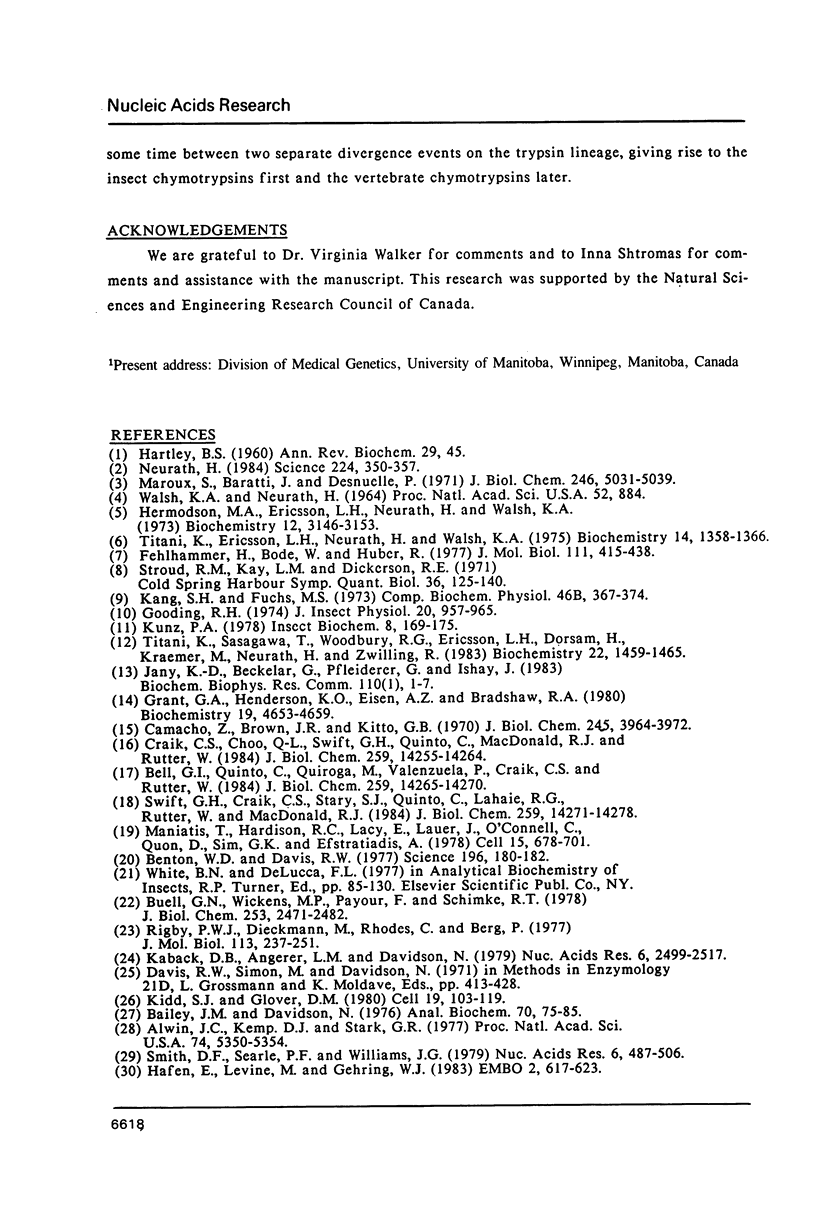
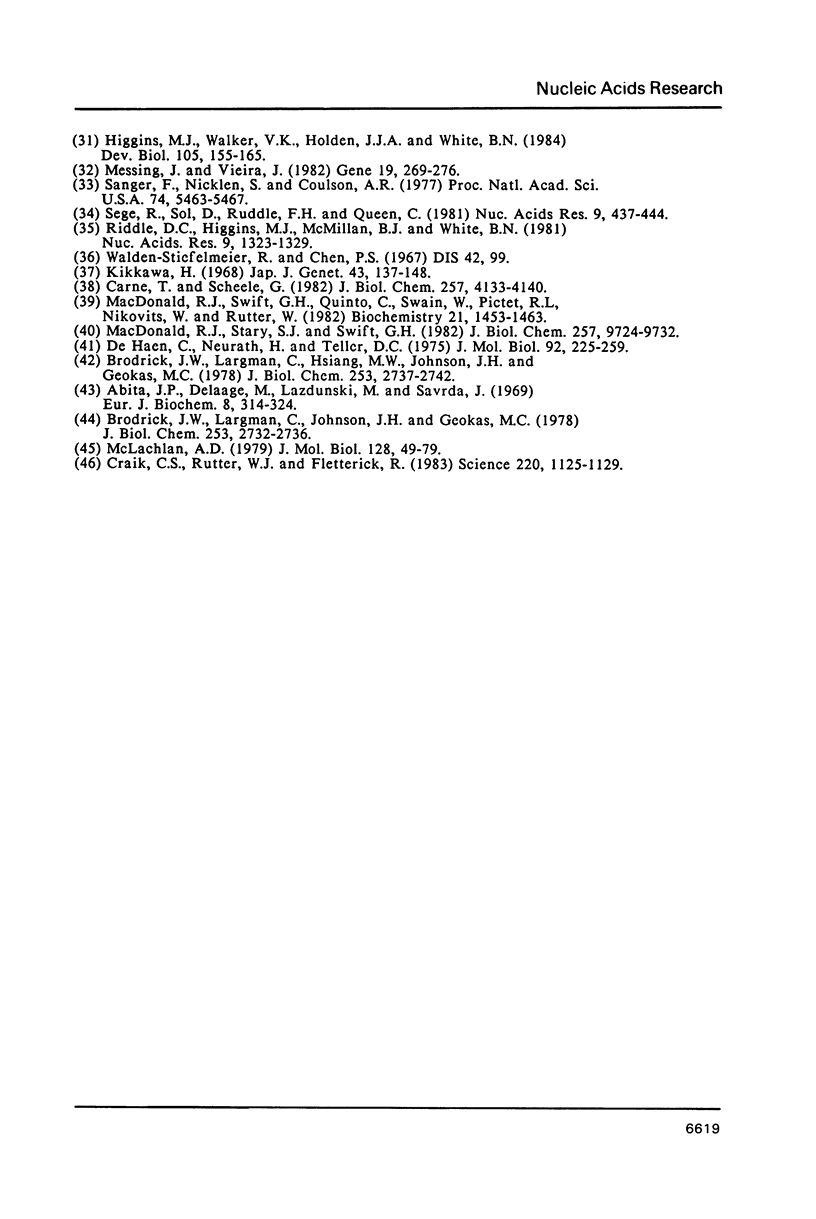
Images in this article
Selected References
These references are in PubMed. This may not be the complete list of references from this article.
- Abita J. P., Delaage M., Lazdunski M. The mechanism of activation of trypsinogen. The role of the four N-terminal aspartyl residues. Eur J Biochem. 1969 Apr;8(3):314–324. doi: 10.1111/j.1432-1033.1969.tb00530.x. [DOI] [PubMed] [Google Scholar]
- Alwine J. C., Kemp D. J., Stark G. R. Method for detection of specific RNAs in agarose gels by transfer to diazobenzyloxymethyl-paper and hybridization with DNA probes. Proc Natl Acad Sci U S A. 1977 Dec;74(12):5350–5354. doi: 10.1073/pnas.74.12.5350. [DOI] [PMC free article] [PubMed] [Google Scholar]
- Bailey J. M., Davidson N. Methylmercury as a reversible denaturing agent for agarose gel electrophoresis. Anal Biochem. 1976 Jan;70(1):75–85. doi: 10.1016/s0003-2697(76)80049-8. [DOI] [PubMed] [Google Scholar]
- Bell G. I., Quinto C., Quiroga M., Valenzuela P., Craik C. S., Rutter W. J. Isolation and sequence of a rat chymotrypsin B gene. J Biol Chem. 1984 Nov 25;259(22):14265–14270. [PubMed] [Google Scholar]
- Benton W. D., Davis R. W. Screening lambdagt recombinant clones by hybridization to single plaques in situ. Science. 1977 Apr 8;196(4286):180–182. doi: 10.1126/science.322279. [DOI] [PubMed] [Google Scholar]
- Brodrick J. W., Largman C., Hsiang M. W., Johnson J. H., Geokas M. C. Structural basis for the specific activation of human enteropeptidase. J Biol Chem. 1978 Apr 25;253(8):2737–2742. [PubMed] [Google Scholar]
- Brodrick J. W., Largman C., Johnson J. H., Geokas M. C. Human cationic trypsinogen. Purification, characterization, and characteristics of autoactivation. J Biol Chem. 1978 Apr 25;253(8):2732–2736. [PubMed] [Google Scholar]
- Buell G. N., Wickens M. P., Payvar F., Schimke R. T. Synthesis of full length cDNAs from four partially purified oviduct mRNAs. J Biol Chem. 1978 Apr 10;253(7):2471–2482. [PubMed] [Google Scholar]
- Camacho Z., Brown J. R., Kitto G. B. Purification and properties of trypsin-like proteases from the starfish Dermasterias imbricata. J Biol Chem. 1970 Aug 10;245(15):3964–3972. [PubMed] [Google Scholar]
- Carne T., Scheele G. Amino acid sequences of transport peptides associated with canine exocrine pancreatic proteins. J Biol Chem. 1982 Apr 25;257(8):4133–4140. [PubMed] [Google Scholar]
- Craik C. S., Choo Q. L., Swift G. H., Quinto C., MacDonald R. J., Rutter W. J. Structure of two related rat pancreatic trypsin genes. J Biol Chem. 1984 Nov 25;259(22):14255–14264. [PubMed] [Google Scholar]
- Craik C. S., Rutter W. J., Fletterick R. Splice junctions: association with variation in protein structure. Science. 1983 Jun 10;220(4602):1125–1129. doi: 10.1126/science.6344214. [DOI] [PubMed] [Google Scholar]
- Fehlhammer H., Bode W., Huber R. Crystal structure of bovine trypsinogen at 1-8 A resolution. II. Crystallographic refinement, refined crystal structure and comparison with bovine trypsin. J Mol Biol. 1977 Apr 25;111(4):415–438. doi: 10.1016/s0022-2836(77)80062-4. [DOI] [PubMed] [Google Scholar]
- Gooding R. H. Digestive processes of haematophagous insects: control of trypsin secretion in Glossina morsitans. J Insect Physiol. 1974 Jun;20(6):957–964. doi: 10.1016/0022-1910(74)90137-1. [DOI] [PubMed] [Google Scholar]
- Grant G. A., Henderson K. O., Eisen A. Z., Bradshaw R. A. Amino acid sequence of a collagenolytic protease from the hepatopancreas of the fiddler crab, Uca pugilator. Biochemistry. 1980 Sep 30;19(20):4653–4659. doi: 10.1021/bi00561a018. [DOI] [PubMed] [Google Scholar]
- HARTLEY B. S. Proteolytic enzymes. Annu Rev Biochem. 1960;29:45–72. doi: 10.1146/annurev.bi.29.070160.000401. [DOI] [PubMed] [Google Scholar]
- Hafen E., Levine M., Garber R. L., Gehring W. J. An improved in situ hybridization method for the detection of cellular RNAs in Drosophila tissue sections and its application for localizing transcripts of the homeotic Antennapedia gene complex. EMBO J. 1983;2(4):617–623. doi: 10.1002/j.1460-2075.1983.tb01472.x. [DOI] [PMC free article] [PubMed] [Google Scholar]
- Hermodson M. A., Ericsson L. H., Neurath H., Walsh K. A. Determination of the amino acid sequence of porcine trypsin by sequenator aalysis. Biochemistry. 1973 Aug 14;12(17):3146–3153. doi: 10.1021/bi00741a002. [DOI] [PubMed] [Google Scholar]
- Higgins M. J., Walker V. K., Holden J. A., White B. N. Isolation of two Drosophila melanogaster genes abundantly expressed in the ovary during vitelline membrane synthesis. Dev Biol. 1984 Sep;105(1):155–165. doi: 10.1016/0012-1606(84)90271-9. [DOI] [PubMed] [Google Scholar]
- Jany K. D., Bekelar K., Pfleiderer G., Ishay J. Amino acid sequence of an insect chymotrypsin from the larvae of the hornet, Vespa orientalis. Biochem Biophys Res Commun. 1983 Jan 14;110(1):1–7. doi: 10.1016/0006-291x(83)91251-2. [DOI] [PubMed] [Google Scholar]
- Kaback D. B., Angerer L. M., Davidson N. Improved methods for the formation and stabilization of R-loops. Nucleic Acids Res. 1979 Jun 11;6(7):2499–2317. doi: 10.1093/nar/6.7.2499. [DOI] [PMC free article] [PubMed] [Google Scholar]
- Kang S. H., Fuchs M. S. The identification of two protease inhibitors in Drosophila melanogaster. Comp Biochem Physiol B. 1973 Oct 15;46(2):367–374. doi: 10.1016/0305-0491(73)90327-1. [DOI] [PubMed] [Google Scholar]
- Kidd S. J., Glover D. M. A DNA segment from D. melanogaster which contains five tandemly repeating units homologous to the major rDNA insertion. Cell. 1980 Jan;19(1):103–119. doi: 10.1016/0092-8674(80)90392-x. [DOI] [PubMed] [Google Scholar]
- MacDonald R. J., Stary S. J., Swift G. H. Two similar but nonallelic rat pancreatic trypsinogens. Nucleotide sequences of the cloned cDNAs. J Biol Chem. 1982 Aug 25;257(16):9724–9732. [PubMed] [Google Scholar]
- MacDonald R. J., Swift G. H., Quinto C., Swain W., Pictet R. L., Nikovits W., Rutter W. J. Primary structure of two distinct rat pancreatic preproelastases determined by sequence analysis of the complete cloned messenger ribonucleic acid sequences. Biochemistry. 1982 Mar 16;21(6):1453–1463. doi: 10.1021/bi00535a053. [DOI] [PubMed] [Google Scholar]
- Maniatis T., Hardison R. C., Lacy E., Lauer J., O'Connell C., Quon D., Sim G. K., Efstratiadis A. The isolation of structural genes from libraries of eucaryotic DNA. Cell. 1978 Oct;15(2):687–701. doi: 10.1016/0092-8674(78)90036-3. [DOI] [PubMed] [Google Scholar]
- Maroux S., Baratti J., Desnuelle P. Purification and specificity of porcine enterokinase. J Biol Chem. 1971 Aug 25;246(16):5031–5039. [PubMed] [Google Scholar]
- McLachlan A. D. Gene duplications in the structural evolution of chymotrypsin. J Mol Biol. 1979 Feb 15;128(1):49–79. doi: 10.1016/0022-2836(79)90308-5. [DOI] [PubMed] [Google Scholar]
- Messing J., Vieira J. A new pair of M13 vectors for selecting either DNA strand of double-digest restriction fragments. Gene. 1982 Oct;19(3):269–276. doi: 10.1016/0378-1119(82)90016-6. [DOI] [PubMed] [Google Scholar]
- Neurath H. Evolution of proteolytic enzymes. Science. 1984 Apr 27;224(4647):350–357. doi: 10.1126/science.6369538. [DOI] [PubMed] [Google Scholar]
- Riddell D. C., Higgins M. J., McMillan B. J., White B. N. Structural analysis of the three vitellogenin genes in Drosophila melanogaster. Nucleic Acids Res. 1981 Mar 25;9(6):1323–1338. doi: 10.1093/nar/9.6.1323. [DOI] [PMC free article] [PubMed] [Google Scholar]
- Rigby P. W., Dieckmann M., Rhodes C., Berg P. Labeling deoxyribonucleic acid to high specific activity in vitro by nick translation with DNA polymerase I. J Mol Biol. 1977 Jun 15;113(1):237–251. doi: 10.1016/0022-2836(77)90052-3. [DOI] [PubMed] [Google Scholar]
- Sanger F., Nicklen S., Coulson A. R. DNA sequencing with chain-terminating inhibitors. Proc Natl Acad Sci U S A. 1977 Dec;74(12):5463–5467. doi: 10.1073/pnas.74.12.5463. [DOI] [PMC free article] [PubMed] [Google Scholar]
- Sege R., Söll D., Ruddle F. H., Queen C. A conversational system for the computer analysis of nucleic acid sequences. Nucleic Acids Res. 1981 Jan 24;9(2):437–444. doi: 10.1093/nar/9.2.437. [DOI] [PMC free article] [PubMed] [Google Scholar]
- Smith D. F., Searle P. F., Williams J. G. Characterisation of bacterial clones containing DNA sequences derived from Xenopus laevis vitellogenin mRNA. Nucleic Acids Res. 1979 Feb;6(2):487–506. doi: 10.1093/nar/6.2.487. [DOI] [PMC free article] [PubMed] [Google Scholar]
- Stroud R. M., Kay L. M., Dickerson R. E. The crystal and molecular structure of DIP-inhibited bovine trypsin at2.7Angstrom resolution. Cold Spring Harb Symp Quant Biol. 1972;36:125–140. doi: 10.1101/sqb.1972.036.01.018. [DOI] [PubMed] [Google Scholar]
- Swift G. H., Craik C. S., Stary S. J., Quinto C., Lahaie R. G., Rutter W. J., MacDonald R. J. Structure of the two related elastase genes expressed in the rat pancreas. J Biol Chem. 1984 Nov 25;259(22):14271–14278. [PubMed] [Google Scholar]
- Titani K., Ericsson L. H., Neurath H., Walsh K. A. Amino acid sequence of dogfish trypsin. Biochemistry. 1975 Apr 8;14(7):1358–1366. doi: 10.1021/bi00678a003. [DOI] [PubMed] [Google Scholar]
- Titani K., Sasagawa T., Woodbury R. G., Ericsson L. H., Dörsam H., Kraemer M., Neurath H., Zwilling R. Amino acid sequence of crayfish (Astacus fluviatilis) trypsin If. Biochemistry. 1983 Mar 15;22(6):1459–1465. doi: 10.1021/bi00275a021. [DOI] [PubMed] [Google Scholar]
- WALSH K. A., NEURATH H. TRYPSINOGEN AND CHYMOTRYPSINOGEN AS HOMOLOGOUS PROTEINS. Proc Natl Acad Sci U S A. 1964 Oct;52:884–889. doi: 10.1073/pnas.52.4.884. [DOI] [PMC free article] [PubMed] [Google Scholar]
- de Haën C., Neurath H., Teller D. C. The phylogeny of trypsin-related serine proteases and their zymogens. New methods for the investigation of distant evolutionary relationships. J Mol Biol. 1975 Feb 25;92(2):225–259. doi: 10.1016/0022-2836(75)90225-9. [DOI] [PubMed] [Google Scholar]





